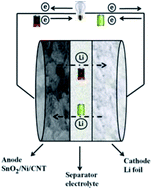A nanostructured SnO2/Ni/CNT composite as an anode for Li ion batteries†
Abstract
A SnO2/Ni/CNT nanocomposite was synthesized using a simple one-step hydrothermal method followed by calcination. A structural study via XRD shows that the tetragonal rutile structure of SnO2 is maintained. Further, X-ray photoelectron spectroscopy (XPS) and Raman studies confirm the existence of SnO2 along with CNTs and Ni nanoparticles. The electrochemical performance was investigated via cyclic voltammetry (CV), electrochemical impedance spectroscopy (EIS), and galvanostatic charge–discharge measurements. The nanocomposite has been used as an anode material for lithium-ion batteries. The SnO2/Ni/CNT nanocomposite exhibited an initial discharge capacity of 5312 mA h g−1 and a corresponding charge capacity of 2267 mA h g−1 during the first cycle at 50 mA g−1. Pristine SnO2 showed a discharge/charge capacity of 1445/636 mA h g−1 during the first cycle at 50 mA g−1. This clearly shows the effects of the optimum concentrations of CNTs and Ni. Further, the nanocomposite (SnNiCn) shows a discharge capacity as high as 919 mA h g−1 after 210 cycles at a current density of 400 mA g−1 in a Li-ion battery set-up. Thus, the obtained capacity from the nanocomposite is much higher compared to pristine SnO2. The higher capacity in the nanoheterostructure is due to the well-dispersed nanosized Ni-decorated stabilized SnO2 along with the CNTs, avoiding pulverization as a result of the volumetric change of the nanoparticles being minimized. The material accommodates huge volume expansion and avoids the agglomeration of nanoparticles during the lithiation and delithiation processes. The Ni nanoparticles can successfully inhibit Sn coarsening during cycling, resulting in the enhancement of stability during reversible conversion reactions. They ultimately enhance the capacity, giving stability to the nanocomposite and improving performance. Additionally, the material exhibits a lower Warburg coefficient and higher Li ion diffusion coefficient, which in turn accelerate the interfacial charge transfer process; this is also responsible for the enhanced stable electrochemical performance. A detailed mechanism is expressed and elaborated on to provide a better understanding of the enhanced electrochemical performance.



 Please wait while we load your content...
Please wait while we load your content...